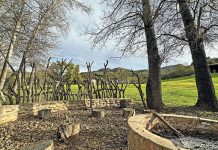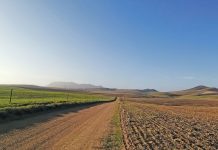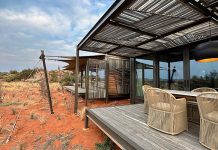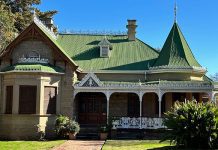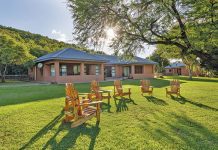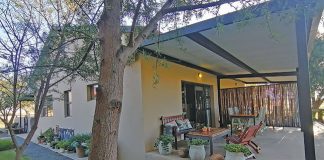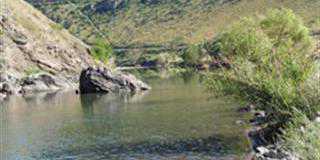With a thunderstorm brewing in the background the tawny eagle Veruschka flies
through the Kalahari sky.
After the intense heat of the day a soothing breeze stirred the yellow leaves of the bushwillows. The smell of dust clung to everything. Not a drop of rain had fallen in three months and not a blade of green showed anywhere. Now the fiery glow of the setting sun filtered through the blackened branches of the thick thorn bush ahead.
There was no sign of the impala for which I had searched for almost an hour. Dusk was setting in and it would soon be dark. Due to the drought they’d dropped their lambs almost a month late, but it would not help as some would not make it to the winter and the grazing would suffer. There were too many and had to reduce them without delay. As the females were suckling it would be better to take out some of the lambs. I would use an eagle for that.
Sensing a sudden movement beyond the thick bushes ahead stopped, switched off my quad bike and listened. On my thick, harness leather glove, supported on my left knee, sat a huge female crowned eagle, totally unrestrained. Weighing almost 4kg and built like a giant goshawk, she was the strongest eagle on the continent. called her Ninja because it reflected her extraordinary killing ability.
Being a forest eagle she was at home in those thickets and with eyesight seven times better than mine, she was fully aware of any movement beyond the screen of branches that obscured my vision. left the decision when to attack to her. uddenly she launched herself on broad, silent wings straight towards the seemingly impenetrable thicket. Her sharp eyes detected a gap even at this low light. On reaching it she closed her wings with split-second timing and dived straight through to be met on the other side by an explosion of snorts and panic. I fired the bike, skirted the bush and raced after her.
The impala were in the open now, with the eagle in hot pursuit of the fleeing herd. She overtook them with ease and in the fading light selected her victim. It was one of the bigger lambs. Flying alongside it, she suddenly turned and attacked. One foot shot out and grabbed the impala by the head and the other its spine.
With a 9cm-long talon through its brain, the lamb was dead before it hit the ground. In the wild, crowned eagles usually kill much smaller prey and as a rule almost never any livestock, except perhaps dogs and cats where human habitation intrudes into their forest habitat. Even then they prefer wild prey such as dassies, monkeys and small forest antelope. On the outskirts of Margate, KZN, once found a crowned eagle nest where remains and skulls of numerous victims, including dozens of cane rats, were scattered. Careful scrutiny revealed no traces of domestic animals. But with the pulverising power in its talons and the help and encouragement of the falconer, a crowned eagle can be transformed pound-for-pound into the most awesome hunter on the planet.
With Ninja I not only hunted numerous hares and springhares, but several jackals and antelope. She once killed a bushbuck ram that weighed more than seven times her weight. That’s equivalent to a cheetah catching a buffalo or a single lion killing a rhino, hippo or female elephant – and doing it in a split second.
Training with the patience of Job
To train an eagle for falconry is more complicated and difficult than training any short-winged hawk and with any of the larger species, more dangerous. Any eagle has such a strong personality that it will never tolerate being dominated. In any relationship with a human it is the master and you are the slave.
You can only win its trust through gentle kindness. must be a bird psychologist and have the patience of Job. If you ever lose your temper or treat it indignantly it will hate you, but if you can get it to love you, it will return to you even when you allow it to soar beyond your vision among the clouds.
N inja has been stolen from her nest as a chick and spent at least the first five years of her life cooped up in a cage. was ill-treated and humiliated, never supplied with a bath, which they indulge in daily, and probably never allowed to kill anything, which was her function in life. Eventually all she craved was to kill people. She was so dangerous that the Natal Parks Board intended to put her down but I offered take her. I first gave her a bath and then kindness, then I flew her free and allowed her to hunt and kill and she loved me for that.
During the production of a documentary for 50/50, I was contracted to take my tawny eagle Veruschka to the Kruger Park to shoot some close-ups at a breeding colony of quelea finches. It was in a remote and trackless part of the park and when we arrived at the colony we not only found lions, hyenas and flocks of marabous feasting on the fledgling finches, but hundreds of eagles perched on the surrounding trees. As we approached they all flew up and I released my eagle to fly with them. After a while the cloud of eagles started to drift away in the distance, and I grew concerned so I called to Veruschka and she separated from the multitude and stooped down to land on my gloved hand. The shoot was a great success.
Art of falconry – it’s what you put in
The secret of flying and hunting any bird of prey is to manage its weight. A bird that is too fat can neither be flown nor hunted. Each bird has an optimum weight which the falconer must determine through trial, at which it has just enough appetite to respond to training, obey orders or pursue quarry for a reward. To achieve this weight the falconer gradually feeds it smaller amounts or less nutritious food, such as chicken breasts.
Eagles in the wild eat large meals at long intervals and have the ability to fast for long periods without losing weight, and that makes their training so much more difficult. It can drive even an experienced falconer up the wall. It is the last thing an inexperienced falconer should even think about.
Unfortunately that is exactly where I began. The first bird that I trained for falconry was a young male Wahlberg’s eagle that the police confiscated after it was stolen from a nest. His wing was also damaged and although I nursed him until he could fly to some extent, Sakkie as I called him, would never be able to return to the wild. Having no experience and no one to teach me, all I could do was read all I could find on falconry. But every book either had nothing on eagles or warned that it should not be attempted. But Sakkie had to have a life, not in a cage but as a hunter – so I persevered. After he could eventually fly, I started his training but it took six months before he flew even 10m to my hand, but persistence paid off and he had a long happy hunting life with me. A fraction of his kills that I did record numbered 281 and he even showed the boys at the Waterkloof Airforce Base how to clear the runway by putting the fear of death into the plovers that played the fool with their peregrines. Maybe it was Sakkie that trained me as a falconer, because after him all other birds were easy. He was eventually killed at the moment of his greatest triumph – he was stoned to death by a vagabond while plucking the feathers off the first rock pigeon he had ever caught. African hawk eagle: SA’s high-flyer The most popular eagle used in falconry in SA is the African hawk eagle. As its name indicates, it has more the temperament of a large goshawk than an eagle and although I never had the opportunity to hunt one, I did train and fly some to fitness in preparation for their release after rehabilitation and found them to be easier than other eagles. In fact, several rehab centres regularly transferred their raptors to me to fly and get them fit before releasing them back into the wild. But it is especially the three mentioned above that have stayed with me and gave me a rare glimpse into the soul of an eagle.
During my lifetime I have seen their demise and this saddens me. These past stories on falconry were intended to bring new understanding to the public about falconry. The aim was not to canvas for new recruits. On the contrary I want to dissuade people to engage in it, as probably fewer than one in 100 000 has the right temperament and circumstances to be a successful falconer. – Abré J Steyn Contact Abré J Steyn on 083 253 4822. |fw

